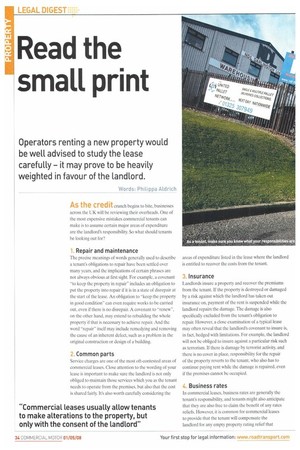Read the small print
Page 34

Page 35

If you've noticed an error in this article please click here to report it so we can fix it.
Operators renting a new property would be well advised to study the lease carefully it may prove to be heavily weighted in favour of the Landlord.
Words: Philippa Aldrich As the credit crunch begins to bite, businesses across the UK will be reviewing their overheads. One of the most expensive mistakes commercial tenants can make is to assume certain major areas of expenditure are the landlord's responsibility. So what should tenants be looking out for?
1. Repair and maintenance
The precise meanings of words generally used to describe a tenant's obligations to repair have been settled over many years, and the implications of certain phrases are not always obvious at first sight. For example, a covenant "to keep the property in repair" includes an obligation to put the property into repair if it is in a state of disrepair at the start of the lease. An obligation to "keep the property in good condition" can even require works to he carried out, even if there is no disrepair. A covenant to "renew", on the other hand, may extend to rebuilding the whole property if that is necessary to achieve repair. And the word "repair" itself may include remedying and removing the cause of an inherent defect, such as a problem in the original construction or design of a building.
2. Common parts Service charges are one of the most oft-contested areas of commercial leases. Close attention to the wording of your lease is important to make sure the landlord is not only obliged to maintain those services which you as the tenant needs to operate from the premises, but also that the cost is shared fairly. It's also worth carefully considering the
areas of expenditure listed in the lease where the landlord is entitled to recover the costs from the tenant.
3. Insurance
Landlords insure a property and recover the premiums from the tenant. If the property is destroyed or damaged by a risk against which the landlord has taken out insurance on, payment of the rent is suspended while the landlord repairs the damage. The damage is also specifically excluded from the tenant's obligation to repair. However, a close examination of a typical lease may often reveal that the landlord's covenant to insure is, in fact, hedged with limitations. For example, the landlord will not be obliged to insure against a particular risk such as terrorism. If there is damage by terrorist activity, and there is no cover in place, responsibility for the repair of the property reverts to the tenant, who also has to continue paying rent while the damage is repaired, even if the premises cannot be occupied.
4. Business rates
In commercial leases, business rates are generally the tenant's responsibility, and tenants might also anticipate that they are also free to claim the benefit of any rates reliefs. However, it is common for commercial leases to provide that the tenant will compensate the landlord for any empty property rating relief that the landlord loses' after the end of the term because it has been awarded to the tenant.
Alterations
Commercial leases usually allow tenants to make alterations to the properly, but only with the consent of the landlord, and subject to a requirement that any alterations are reversed at the end of a lease. A common mistake on the part of a tenant is to assume that because they have improved the property, the landlord will not require the alterations to be reversed when they leave. However, unless expressly agreed otherwise, the landlord is entitled to insist that the alterations are removed.
6. Disability Discrimination Act 1995
The DD A requires a "provider of services" to take steps to make its services accessible to disabled people, which may include making physical adjustments to access to the properly. This duty falls upon whoever is providing the service, and this can be the landlord, the tenant or both.
7. Fire prevention
Fire certificates have been superseded by the Regulatory Reform (Fire Safety) Order 2005, which came into force in October 2006. The order imposes a new regime of self-assessment and a tenant is likely to be the 'responsible person' for ensuring compliance in relation to the property it occupies. Compliance can be expensive.
8. Contamination
Where property has been previously contaminated, a remediation notice requiring the property to be cleaned up is generally served on the landlord rather than the tenant. But commercial leases will often provide that the tenant is responsible for complying with all legislation in relation to a property and for carrying out any work required by law. Such a clause would make the tenant liable for the clean up of historic contamination, even if the notice was served on the landlord.
9. Asbestos
Regulation 4 of the Control of Asbestos at Work Regulations 2002 came into force on 21 May 2004 and created a significant new duty to manage asbestos risk in "non-domestic premises". This includes determining if asbestos is present in a building or is likely to be present and managing any asbestos identified. Under Regulation 4, a range of people will be liable, and this can include tenants as well as landlords.
0 Philippa Aldrich is a partner in the Real Estate Group of Shadboh & Co LLP




















































































































































































